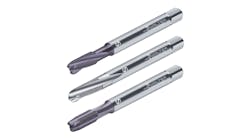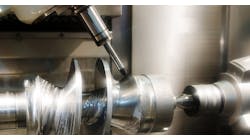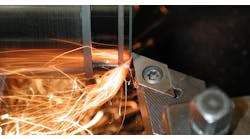The broaching process, similar to shaping with multiple teeth, is used to machine internal and external surfaces such as holes of circular, square, or irregular shapes, keyways and teeth of internal gears. A broach is a long multi-tooth cutting tool with successively deeper cuts. Each tooth removes a predetermined amount of material in a predetermined location. The total depth of material removed in one path is the sum of the depth of cut of each tooth. Broaching can produce parts with very good surface finish and dimensional accuracy.
Broaching competes favorably with other processes, such as boring, milling, shaping and reaming. Although broaches tend to be expensive, the cost is justified because of their use for high-production runs.
The broaching process
Tooling is the heart of any broaching process. The broaching tool is based on a concept unique to the process-- rough, semi-finish and finish cutting teeth combined in one tool or string of tools. A broach tool frequently can finish machine a rough surface in a single stroke.
For exterior surface broaching, the broach tool may be pulled or pushed across a workpiece surface, or the surface may move across the tool. Internal broaching requires a starting hole or opening in the workpiece so the broaching tool can be inserted. The tool or the workpiece is then pushed or pulled to force the tool through the starter hole. Almost any irregular cross-section can be broached as long as all surfaces of the section remain parallel to the direction of broach travel.
Broaching tools — A broach is like a single point tool with many "points," each of which cuts like a flat-ended shaper tool, although some broaches have teeth set diagonally, which is called shear cutting. (“Shear” refers to a straining action wherein applied forces produce a sliding or skewing type of deformation.)
Broach nomenclature
Front pilot: When an internal pull broach is used, the pull end and front pilot are passed through the starting hole. Then the pull end is locked to the pull head of the broaching machine. The front pilot assures correct axial alignment of the tool with the starting hole, and serves as a check on the starting hole size.
Length: The length of a broach tool, or string of tools, is determined by the amount of stock to be removed, and limited by the machine stroke.
Rear pilot: The rear pilot maintains tool alignment as the final finish teeth pass through the workpiece hole. On round tools the diameter of the rear pilot is slightly less than the diameter of the finish teeth.
Cutting teeth: Broach teeth are usually divided into three separate sections along the length of the tool: the roughing teeth, semi-finishing teeth and finishing teeth. The first roughing tooth is proportionately the smallest tooth on the tool. The subsequent teeth progressively increase in size up to and including the first finishing tooth. The difference in height between each tooth, or the tooth rise, is usually greater along the roughing section and less along the semi-finishing section. All finishing teeth are the same size. The face is ground with a hook or face angle that is determined by the workpiece material. For instance, soft steel workpieces usually require greater hook angles; hard or brittle steel pieces require smaller hook angles.
Tooth land: The land supports the cutting edge against stresses. A slight clearance or back-off angle is ground onto the lands to reduce friction. On roughing and semi-finishing teeth, the entire land is relieved with a back-off angle. On finishing teeth, part of the land immediately behind the cutting edge is often left straight, so that repeated sharpening (by grinding the face of the tooth) will not alter the tooth size.
Tooth pitch: The distance between teeth, or pitch, is determined by the length of cut and influenced by type of workpiece material. A relatively large pitch may be required for roughing teeth to accommodate a greater chip load. Tooth pitch may be smaller on semi-finishing teeth to reduce the overall length of the broach tool. Pitch is calculated so that, preferably, two or more teeth cut simultaneously. This prevents the tool from drifting or chattering.
Tooth gullet: The depth of the tooth gullet is related to the tooth rise, pitch and workpiece material. The tooth root radius is usually designed so that chips curl tightly within themselves, occupying as little space as possible.
Chip load: As each tooth enters the workpiece, it cuts a fixed thickness of material. The fixed chip length and thickness produced by broaching create a chip load that is determined by the design of the broach tool and the predetermined feedrate.
Chipbreakers: Notches, called chipbreakers, are used on broach tools to eliminate chip packing and to facilitate chip removal. The chipbreakers are ground into the roughing and semi-finishing teeth of the broach, parallel to the tool axis. Chipbreakers on alternate teeth are staggered so that one set of chipbreakers is followed by a cutting edge. The finishing teeth complete the job. Chipbreakers are vital on round broaching tools: without the chipbreakers, the tools would machine ring-shaped chips that would wedge into the tooth gullets and eventually cause the tool to break.
Shear angle: Broach designers may place broach teeth at a shear angle to improve surface finish and reduce tool chatter. When two adjacent surfaces are cut simultaneously, the shear angle is an important factor in moving chips away from the intersecting corner to prevent crowding of chips in the intersection of the cutting teeth.
Side relief: When broaching slots, the tool becomes enclosed by the slot during cutting and must carry the chips produced through the entire length of the workpiece. Sides of the broach teeth will rub the sides of the slot and cause rapid tool wear unless clearance is provided. Grinding a single relief angle on both sides of each tooth does this. Thus, only a small portion of the tooth near the cutting edge, called the side land, is allowed to rub against the slot. The same approach is used for one-sided corner cuts and spline broaches.
Types of broaches
Two major types of broaches are the push broach and the pull broach. A second division is internal and external broaches.
Push and pull broaches — A push broach must be relatively short since it is a column in compression and will buckle and break under too heavy a load. Push broaches are often used with a simple arbor press if quantities of work are low. For medium- to high-volume production they are used in broaching machines.
Pull broaches are pulled either up, down or horizontally through or across the workpiece, always by a machine. Flat or nearly flat broaches may be pull type, or the broach may be rigidly mounted, with the workpiece then pulled across the broaching teeth. Automobile cylinder blocks and heads are often faced flat by this method.
Internal broaches — Internal broaches are either pulled or pushed through a starter hole. The machines can range from fully automated multi-stationed verticals to horizontal pull types to simple presses.
Keyway broach — Almost all keyways in machine tools and parts are cut by a keyway broach--a narrow, flat bar with cutting teeth spaced along one surface. Both external and internal keyways can be cut with these broaches. Internal keyways usually require a slotted bushing or horn to fit the hole, with the keyway broach pulled through the horn, guided by the slot.
If a number of parts, all of the same diameter and keyway size, are to be machined, an internal keyway broach can be designed to fit into the hole to support the cutting teeth. Only the cutting teeth extend beyond the hole diameter to cut the keyway. Bushings or horns are not required.
Burnishers — Burnishers are broaching tools designed to polish rather than cut a hole. The total change in diameter produced by a burnishing operation may be no more than 0.0005 to 0.001 inches. Burnishing tools, used when surface finish and accuracy are critical, are relatively short and are generally designed as push broaches.
Shell broaches — Shell broaches can be used on the roughing, semi-finishing and finishing sections of a broach tool. The principal advantage of a shell broach is that worn sections can be removed and re-sharpened or replaced, at far less cost than a conventional single piece tool. When shells are used for the finishing teeth of long broaches, the teeth of the shell can be ground to far greater accuracy than those of a long conventional broach tool and the tool can continue to be used by replacing the shell. (Shell broaches are similar to shell milling cutters that were discussed in Chapter 12.)
Surface broaches — The broaches used to remove material from an external surface are commonly known as surface broaches. Such broaches are passed over the workpiece surface to be cut, or the workpiece passes over the tool on horizontal, vertical or chain machines to produce flat or contoured surfaces.
While some surface broaches are of solid construction, most are of built-up design, with sections, inserts or indexable tool bits that are assembled end-to-end in a broach holder or sub holder. The holder fits on the machine slide and provides rigid alignment and support.
Types of broaching machines
The type of broach cutting tool required for a given job is the single most important factor in determining the type of broaching machine to be used. Second in importance is the production requirement. Taken together, these factors usually determine the specific type of machine for the job.
The type of broach tool (internal or surface) immediately narrows down the kinds of machines that could be used. The number of pieces required per hour, or over the entire production run, will further narrow the field.
For internal broaching, the length of a broach in relation to its diameter may determine whether it must be pulled rather than pushed through the workpiece, for a broach tool is stronger in tension than in compression. This in turn, helps determine the type of machine for the job.
The type of drive, hydraulic or electromechanical, is another important factor in machine selection. So are convertibility and automation. Some machine designs allow for conversion from internal to surface work. Some designs are fully automated; others are limited in scope and operate only with close operator supervision.
Vertical broaching machines — About 60 percent of the total numbers of broaching machines in existence are vertical, almost equally divided between vertical internals and vertical surface or combination machines. Vertical broaching machines, used in every major area of metalworking, are almost all hydraulically driven.
One of the essential features that promoted their development, however, is beginning to turn into a limitation. Cutting strokes now in use often exceed existing factory ceiling clearances. When machines reach heights of 20 feet or more, expensive pits must be dug for the machine so that the operator can work at the factory floor level. A large vertical broaching machine is shown below.
Vertical internal broaching machines are table-up, pull-up, pull-down or push-down, depending on their mode of operation.
Vertical table-up. Today, table-up machines are demanded to meet the cell concept (flexible) manufacturing, where short runs of specialized components are required. Upon completion of short runs (1 to 2 years), the machines can be re-tooled and moved to another area of the plant without the problem of what to do with pits in shop floors. With this type of machine the part sits on a table that moves up while the broach is stationary. Stroke lengths from 30' to 90 and capacities from 5 to 30 tons are the limits for this machine.
Vertical internal pull-up. The pull-up type, in which the workpiece is placed below the worktable, was the first to be introduced. Its principal use is in broaching round and irregular shaped holes. Pull-up machines are now furnished with pulling capacities of 6 to 50 tons, strokes up to 72 inches, and broaching speeds of 30 FPM. Larger machines are available; some have electro-mechanical drives for greater broaching speed and higher productivity.
Vertical internal pull-down. The more sophisticated pull-down machines, in which the work is placed on top of the table, were developed later than the pull-up type. These pull-down machines are capable of holding internal shapes to closer tolerances by means of locating fixtures on top of the worktable. Machines come with pulling capacities of 2 to 75 tons, 30-inch inches to 110-inch strokes, and speeds of up to 80 FPM.
Vertical internal push-down. Vertical push-down machines are often nothing more than general-purpose hydraulic presses with special fixtures. They are available with capacities of 2 to 25 tons, strokes up to 36 inchesand speeds as high as 40 FPM. In some cases, universal machines have been designed which combine as many as three different broaching operations, such as push, pull, and surface, simply through the addition of special fixtures.
Horizontal broaching machines — The favorite configuration for broaching machines seems now to have come full circle. The original gear or screw driven machines were designed as horizontal units. Gradually, the vertical machines evolved as it became apparent that floor space could be much more efficiently used with vertical units. Now the horizontal machine, both hydraulically and mechanically driven, is again finding increasing favor among users because of its very long strokes and the limitation that ceiling height places on vertical machines. About 40 percent of all broaching machines are now horizontals. For some types of work such as roughing and finishing automotive engine blocks, they are used exclusively.
Horizontal internal broaching machines. By far the greatest amount of horizontal internal broaching is done on hydraulic pull type machines for which configurations have become somewhat standardized over the years. Fully one-third of the broaching machines in existence are this type, and of these nearly one fourth are over twenty years old. They find their heaviest application in the production of general industrial equipment but can be found in nearly every type of industry.
Hydraulically driven horizontal internal machines are built with pulling capacities ranging from 2 1/2 to 75 tons, the former representing machines only about 8 feet long the latter machines over 35 feet long. Strokes up to 120 inches are available, with cutting speeds generally limited to less than 40 FPM.
Horizontal surface broaching machines. This type accounts for only about 10 percent of existing broaching machines, but this is not indicative of the percentage of the total investment they represent or of the volume of work they produce. Horizontal surface broaching machines belong in a class by themselves in terms of size and productivity. Only the large continuous horizontal units can match or exceed them in productivity. Horizontal surface units are manufactured in both hydraulically and electromechanically driven models, with the latter now becoming dominant.
The older, hydraulically driven horizontal surface machines now are produced with capacities up to 40 tons, strokes up to 180 inches and normal cutting speeds of 100 FPM. These machines, a major factor in the automotive industry for many years, turn out a great variety of cast iron parts. They use standard carbide cutting tools and have some of the highest cutting speeds used in broaching.
But electromechanically driven horizontal surface machines are taking over at an ever-increasing rate for some applications, despite their generally higher cost. Because of their smooth ram motion and the resultant improvements in surface finish and part tolerances, these machines have become the largest class of horizontal surface broaching units built. They are available with pulling capacities in excess of 100 tons, strokes up to 30 feet and cutting speeds, in some instances, of over 300 FPM.
Chain-broaching machines — These have been the most popular type of machine produced for high-production surface broaching. The key to the productivity of a continuous horizontal broaching machine is elimination of the return stroke by mounting the workpieces, or the tools, on a continuous chain.
Most frequently, the tools remain stationary, mounted in a tunnel in the top half of the machine, and the chain mounted workpieces pass underneath them.
Turn-broaching
Turn-broaching is an efficient method for machining steel and nodular cast iron crankshafts. Special turn-broaching machines are available for linear, circular and spiral operating methods. The peripheral type cutter assemblies are built in segments.
The turn-broaching systems basically use similar standardized components for roughing and finishing. The type of machine determines the tool design: linear, circular or spiral. The number of segments and roughing inserts in the tool depend on the stock removal rate required. The finishing segments are fitted with inserts in adjustable cartridges that can be set to close tolerances. The segment for roughing has fixed insert pockets. A turn-broaching operation of a crankshaft is shown below.
Tool segments are computer designed and manufactured for each machine to suit the required form and tolerance of each crankshaft. The number of inserts and positions of each segment are designed to give low cutting forces. The roughing segments have hardened, fixed insert seats and big chip pockets. Inserts are tangentially mounted and locked in position by a center screw.
Long tool life results because of the short engagement of the individual cutting edges. High machine utilization is obtained because the finishing cutters need only be changed once per shift and the roughing cutters about once every third shift.
George Schneider, Jr., is the author of Cutting Tool Applications, a handbook to machine tool materials, principles, and designs. He is the Professor Emeritus of Engineering Technology at Lawrence Technological University, and former Chairman of the Detroit Chapter of the Society of Manufacturing Engineers.








